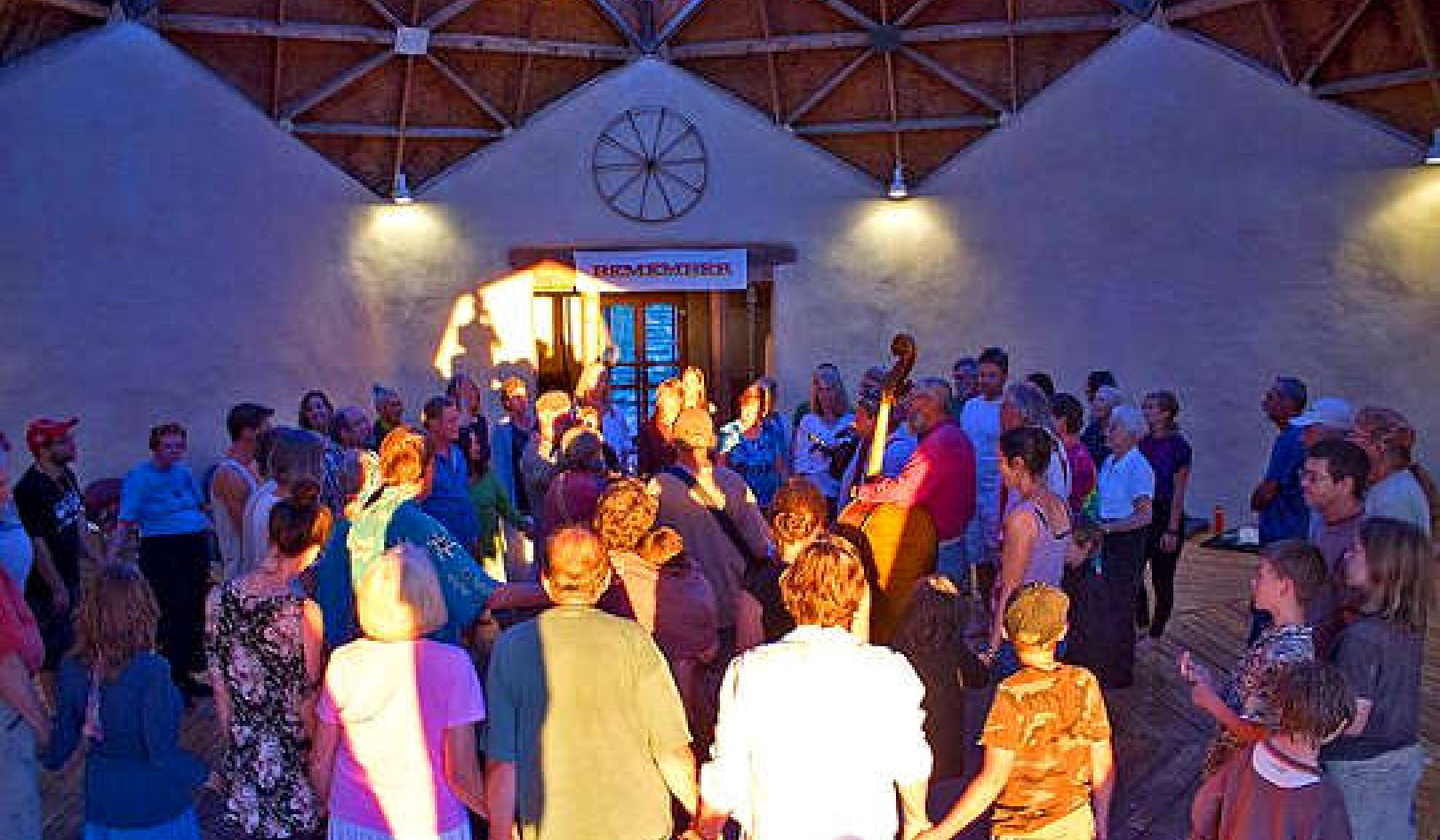
How do we integrate our spiritual practice into our daily life and professional work? How do we really bring it alive in the world, make it acceptable to our friends, co-workers, and clients? How do we celebrate our interconnectedness in our work and in our relationships in the world?
My peace activist work began in 1985 when I was part of a six-month training program for the Special Forces — the Green Berets. My husband and I took a group of twenty for a one-month meditation retreat in New Hampshire. It was a wonderful opportunity and also quite a challenge to meet face-to-face all our prejudices about the military. Together with our students, we began to let go of our cultural conditioning and see things from other perspectives. We dropped our prejudgments and accepted others simply as human beings, all wanting to be happy.
No Separation Between Meditation and Relationships and Work
How do we fashion our daily lives so that we contribute to the spiritual growth of ourselves and others, so that there is no separation between our meditation practice and our relationships and our work in the world? Here I would like to share with you meditations that I have found useful in my own life.
Each of these meditations is complete in itself and each ties into the theme of human interaction and the interrelatedness of all life. All are based on the understanding that we are not alone; we live in relationship with others. Our meditation practice is intimately connected to other people — in our work and in every aspect of our lives.
Gen Lamrimpa, the Tibetan lama who led our one-year retreat, was in Seattle in 1988, he told us, “As you are driving down the freeway in your car, recognize that all the people on the freeway want to reach their destination — some place that will bring them happiness and fulfillment. Just radiate to them: May you reach your destination safely. Cultivating that attitude will be the best protection you can have.”
I remember asking, “But what if they don’t have a positive goal in mind?” and he said, “That’s none of your business. You are cultivating your mind wishing for their happiness. Do not concern yourself with judging the correctness of their goal.”
Creating a field of loving-kindness like this is a very powerful meditation for daily life. Loving-kindness and a good heart create the most powerful protection.
Generating Loving-Kindness and Transforming Negativity
 I learned a very beneficial technique for generating loving-kindness and transforming negativity from a Bengali teacher of the Burmese Theravada tradition, Dipa Ma. She is considered a saint, highly attained, and pure of mind. In this meditation, we focus awareness on the flow of the breath rising and falling in the chest. Notice any feelings of warmth, tingling, vibration, or movement at the heart and allow that region to become soft, open, and radiant. All of us can remember being in the presence of someone with strong loving-kindness. Bask in that feeling of warmth, affection, and caring.
I learned a very beneficial technique for generating loving-kindness and transforming negativity from a Bengali teacher of the Burmese Theravada tradition, Dipa Ma. She is considered a saint, highly attained, and pure of mind. In this meditation, we focus awareness on the flow of the breath rising and falling in the chest. Notice any feelings of warmth, tingling, vibration, or movement at the heart and allow that region to become soft, open, and radiant. All of us can remember being in the presence of someone with strong loving-kindness. Bask in that feeling of warmth, affection, and caring.
To do this meditation authentically, first we need to send a lot of love to ourselves. This is very difficult for some people, but to perfect this practice, we need to care about ourselves, too. We bring to mind our own image, like looking in a mirror, and repeat the following phrases softly:
May I be free from enmity: May I be free from aversion, ill will, hatred, and anger, hostility, and irritation toward myself and others.
May I be free from danger: May I be free from all harms, diseases, accidents, and other dangers.
May I be free from disease: May I be healthy on all levels.
May Ibehappy:May my heart be open, truly happy, and all wishes fulfilled.
May I be free from suffering:May I be free from all physical, mental, and emotional sufferings.
As we breathe in, we breathe in all feelings of loving-kindness, happiness, and caring, filling our whole being.
Next, calling to mind an image of a teacher or friend who has been very kind, visualize someone who naturally arouses these feelings. Focus on that person as representing all our kind relatives, friends, benefactors, and helpers. Behold that person’s face as clearly and vividly as possible, generate loving-kindness, and again repeat:
May you be free from enmity.
May you be free from danger.
May you be free from disease.
May you be happy.
May you be free from suffering.
Now allow that image to dissolve back into empty space and out of that emptiness, generate an awareness of all the suffering beings in the world, a general, pervasive sense of all the many beings around the globe who are suffering mentally, physically, and emotionally. Allow the spontaneous flow of images to arise in your mind, direct the focus of your concentration on loving-kindness to all types of suffering beings, and repeat:
May we be free from enmity.
May we be free from disease.
May we be free from danger.
May we be happy.
May we be free from suffering.
A Radiant Powerful Way of Being in Daily Life
Imagine what it would be like to go beyond the words of this meditation to the feelings pointed to by the words. Imagine what it would be like to build the strength of those feelings so that they become a radiant powerful way of being with which to move through our daily life and work.
In this way, our practice follows the cycle of the three higher trainings of ethics, concentration, and wisdom. We go full circle in an ever-increasing upward spiral of integrating and celebrating the inextricable interweaving of our spiritual work and our daily lives.
Reprinted with permission of the publisher,
Snow Lion Publications. http://www.snowlionpub.com
©1995, 2010 Karma Lekshe Tsomo.
Article Source
 Buddhism Through American Women's Eyes
Buddhism Through American Women's Eyes
(a collection of essays by various authors)
edited by Karma Lekshe Tsomo.
Click here for more info or to order this book on Amazon.
About the Author of this excerpt (Chapter 5)
 Michelle Levey, M.A., is President of InnerWork Technologies, a Seattle-based consulting firm and has co-authored numerous books with her husband, including The Fine Arts of Relaxation, Concentration & Meditation and Quality of Mind. She has also served as senior consultant for SportsMind, Inc., and as lead clinician for the Biofeedback and Stress Management Clinic at Childrens' Hospital in Seattle. Michelle has trained intensively in the Theravada and Tibetan Buddhist traditions.
Michelle Levey, M.A., is President of InnerWork Technologies, a Seattle-based consulting firm and has co-authored numerous books with her husband, including The Fine Arts of Relaxation, Concentration & Meditation and Quality of Mind. She has also served as senior consultant for SportsMind, Inc., and as lead clinician for the Biofeedback and Stress Management Clinic at Childrens' Hospital in Seattle. Michelle has trained intensively in the Theravada and Tibetan Buddhist traditions.
About the Book's Editor
 Karma Lekshe Tsomo is an associate professor of Theology and Religious Studies at the University of San Diego, where she teaches classes in Buddhism, World Religions, Comparative Ethics, and Religious Diversity in India. She studied Buddhism in Dharamsala for 15 years and completed a doctorate in philosophy at the University of Hawai'i with research on death and identity in China and Tibet. An American Buddhist nun practicing in the Tibetan tradition, Dr. Tsomo was a founder of Sakyadhita International Association of Buddhist Women (www.sakyadhita.org). She is the director of Jamyang Foundation (www.jamyang.org), an initiative to provide educational opportunities for women in developing countries.
Karma Lekshe Tsomo is an associate professor of Theology and Religious Studies at the University of San Diego, where she teaches classes in Buddhism, World Religions, Comparative Ethics, and Religious Diversity in India. She studied Buddhism in Dharamsala for 15 years and completed a doctorate in philosophy at the University of Hawai'i with research on death and identity in China and Tibet. An American Buddhist nun practicing in the Tibetan tradition, Dr. Tsomo was a founder of Sakyadhita International Association of Buddhist Women (www.sakyadhita.org). She is the director of Jamyang Foundation (www.jamyang.org), an initiative to provide educational opportunities for women in developing countries.
























